Clearing Up Misconceptions about Spray Foam Insulation
injection foam insulation | spray foam insulation | existing home insulation
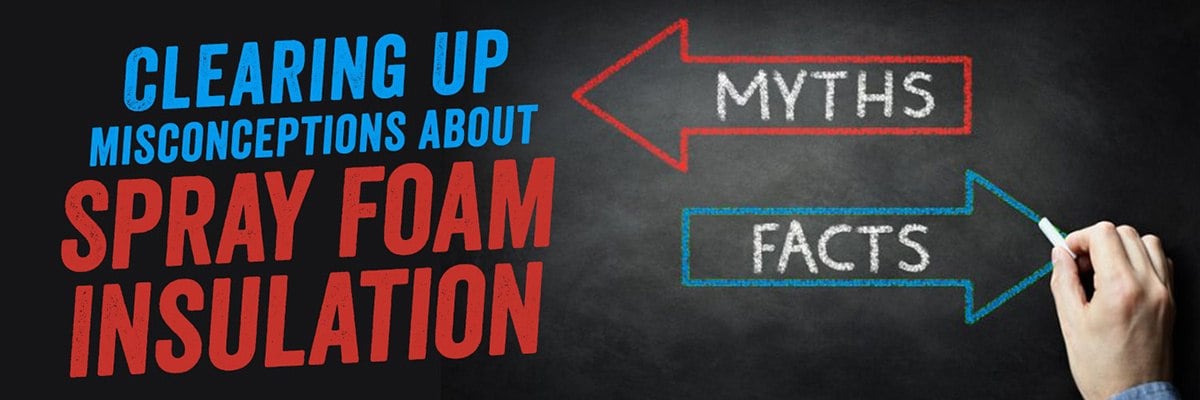

It’s easy to have misconceptions about spray foam insulation when there is so much information, and misinformation, right at your fingertips.
Then you have to take into account information you might hear from friends or family that they heard second hand from someone else. It’s like playing “Telephone” when you were a kid. The message starts off as one thing, and by the time it gets to the end of the chain, it is something completely different.
Over the years, foam insulation has changed drastically, so something that may have been true 20 years ago wouldn’t be the case today. Also, not all foam is created equal, so you can’t lump it all into one category. There are many products and manufacturers, so you can’t compare apples to apples.
RetroFoam of Michigan has more than 17 years of experience insulating thousands of homes and pole barns across the lower peninsula and the greater Toledo area. We hear a lot of misconceptions about foam insulation and work to make sure we clear up any wrong ideas about the material. Our staff helped us put together this list of misconceptions adding their insights to dispel any misinformation.
From ruining shingles to spray foam’s overwhelming smell to existing walls must be torn down to insulate your home, we’re going to address and clear up the most popular myths and misconceptions about foam insulation.
Popular Foam Insulation Myths and Misconceptions
Misconception (noun) – An erroneous conception; mistaken notion. A false or mistaken view, opinion, or attitude.
Misconception: Closed Cell Spray Foam Adds Structural Support to the Home
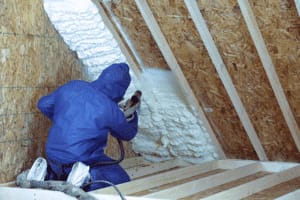 While it’s true that closed cell spray foam insulation is a durable material, it’s not that durable.
While it’s true that closed cell spray foam insulation is a durable material, it’s not that durable.
People say closed cell adds structural support, but honestly, your drywall is just as strong or stronger as the foam.
“If you are needing your insulation to add structural integrity to your home, you have bigger design problems than insulation,” said Mark Massey, owner of RetroFoam of Michigan.
RELATED: What is Closed Cell Spray Foam Insulation? What it’s Made of, How it Works, & More
Misconception: Spraying Foam Insulation on the Roof Deck Ruins the Shingles
In the early days of insulating attics, people believed the insulation was a heat source.
That’s not the case, as the insulation is actually a barrier between two areas of different temperatures. As for the “hot roof” theory, the unvented attic system could make the roof's temperature go up a little. Still, this increase won’t cause damage to your shingles.
“It’s been scientifically proven that the temp of the shingles rises only a couple of degrees when there is an unvented attic compared to a vented attic,” said Garry Barlow, project manager at RetroFoam of Michigan. “If we lived in a southern state, it has been proven that the longevity of the shingle did diminish by only one year. In the northern states, there was no difference in the life span of the shingles.”
RELATED: What is a Hot Roof?
Misconception: The Spray Foam Will Smell for Years
It’s important to know exactly what your contractor is spraying in your home and that they are an experienced foam insulation contractor.
The materials used by RetroFoam of Michigan have little to no odor, but there are products out there that have an odor.
“We do our research on what we spray, so you don’t have to suffer the consequences,” said Tom McTaggart, project manager at RetroFoam of Michigan. “Our products have the fastest occupancy time. We’ve even sprayed an attic that was above terminally ill children in Saginaw.
RELATED: Is Spray Foam Insulation Safe to Have in My Home?
Misconception: Open Cell Spray Foam Absorbs Water Like a Sponge
There are some open cell foam products on the market that do absorb water like a sponge, but there are also some that do not.
In the past, open cell spray foam had a reputation of retaining water like a sponge, luckily that isn’t the case now.
One of the benefits of open cell is that is doesn’t retain water and doesn’t promote mold and mildew growth.
“That’s why it’s crucial for you to know exactly what’s being used for your project,” said Eric Garcia, general manager at RetroFoam of Michigan. “We only use open cell foam that does not absorb water or moisture.”
RELATED: What is Open Cell Spray Foam Insulation? What it’s Made of, How it Works, & More
Misconception: Closed Cell is Best for the Attic Roof Deck or Floor
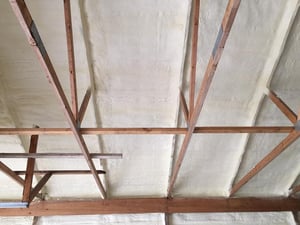 Many people believe closed cell spray foam is the best option for the attic because of its higher R-Value, but in reality, both open and closed cell foams act as an air seal.
Many people believe closed cell spray foam is the best option for the attic because of its higher R-Value, but in reality, both open and closed cell foams act as an air seal.
Open cell is actually the best option for your roof deck, no matter what climate zone you live in. This is because if there are any leaks in the roof, the open cell will show you, while closed cell will block the leak holding the moisture to the wood frame, which can cause a lot of problems.
“Once the leak is fixed, the foam will act much like a wick in an old-style lantern,” said Josh Hammond, project manager at RetroFoam of Michigan. “The foam won’t retain the moisture, just like the wick of the old oil lantern.”
RELATED: Open Cell vs Closed Cell Foam Insulation: Which is Better for My Home?
Misconception: I Have to Leave My Home for an Extended Period after the Spray Foam has been Installed
No, you actually don’t even have to leave your home. It’s just recommended that you not be in the immediate area.
“I once had a homeowner tell me she was told by another foam insulation company that she couldn’t return home for 24 hours,” Barlow said. “That’s not the case with our products. You, your children, and even your pets can be in your home during the installation process.”
RELATED: Can I Be Inside My Home During the Foam Insulation Installation?
Misconception: Foam Insulation Shrinks Over Time
Poorly applied or mixed foam insulation can have issues when installed, which has led to this misconception.
When installed properly in adequate conditions, the foam insulation we use does not shrink.
“Experience is an absolute must when dealing with foam insulation,” said Steve Storms, project manager at RetroFoam of Michigan. “It’s important that you hire a contractor that knows exactly what they are doing.”
Misconception: Spray Foam Can’t be Installed in the Winter Months
Spray foam insulation can be installed in any weather conditions, all year long.
The only exception is if the weather conditions are too severe for workers to be outside.
“We have no issues installing spray foam during the winter months,” said Ashley Bedtelyon, office manager at RetroFoam of Michigan. “It’s something we are trained to do all year long.”
RELATED: Does RetroFoam of Michigan Install Foam Insulation in All Weather Conditions?
Misconception: Existing Exterior Walls Can Be Insulated Through the Top Plate in the Attic
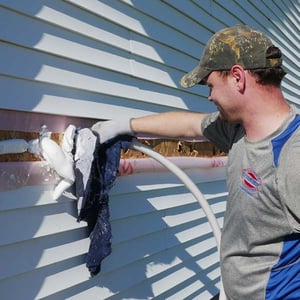 Our process to retrofit existing walls is quick, simple, and typically takes just one day.
Our process to retrofit existing walls is quick, simple, and typically takes just one day.
Most walls are insulated from the outside, but we can also inject foam into the walls from the inside if needed, but never through the attic.
“No, the walls can’t be insulated through the top plate,” said Mike Weaver, project manager at RetroFoam of Michigan. “That area is extremely hard to access, and we wouldn’t be able to get a successful cavity fill from that far up. Also, if there are obstructions or windows, we’d have to go below and inject into the cavity anyways.”
RELATED: RetroFoam Injection Foam Insulation for Existing Walls
Misconception: Electrical Work and New Wires Can’t Be Run with Foam Insulation in the Walls
Open cell foam insulation is a pliable material, which means it is easy to work with if you need to do any rewiring in the future.
Injection foam in the walls also makes it easier to just push the fish tape right through it for the new wiring.
“You can push a wire or fish a wire through open cell foam,” said Weaver. “If the wall is open, you can even cut out the section with a knife.”
RELATED: Fishing Wires in Insulated Walls: How to Snake a Wire Through a Wall with Insulation
Misconception: Foam Insulation Will Seal all the Small Gaps Around Windows and Doors
Foam insulation will fill all of the nooks and crannies in the cavities where it is directly applied.
With that being said, there is a small cavity around windows and doors that the injection foam can’t get to.
In new construction, we fill this cavity with a special window and door foam to ensure these small areas are filled. With existing homes, we can’t get into the cavity, but there is still a fix.
“Foam insulation will make it a little better, but not completely fix it,” Weaver said. “If you can fit a fingernail around the trim, you know you will get air leakage. Get clear silicone calk and seal around the window and door trim to help prevent this.”
Misconception: A House Needs to Breathe and Foam Insulation Will Make it too Tight
When you’re concerned about your house being too tight, you’re more concerned about the air quality and humidity in your home.
In a new build home, an HVAC contractor will determine the size of the system your home needs, which in turn can keep your home from being too tight. The mechanicals should handle the air exchange your new home needs.
If you’re worried about your existing home, while this rarely happens, the fix is actually pretty easy.
“Turning on a bathroom fan or kitchen hood once daily will exchange the air in your house, so you have fresh air coming in,” said Bruce Vaydik, project manager at RetroFoam of Michigan.
RELATED: Airtight House: Can Spray Foam Make My House Too Tight?
Misconception: Foam Insulation Can Completely Soundproof a Room
While foam insulation won’t eliminate the outdoor noise completely, it will greatly reduce it.
One thing to keep in mind is that the location of your ductwork, pipes, appliances, and the general construction of your home will also impact sound.
“Foam insulation doesn’t soundproof, but it can dampen sound up to 80 percent,” said Joe Skelton, project manager at RetroFoam of Michigan. “Open cell has sound deadening qualities, but closed cell doesn’t.”
RELATED: Reduce Airborne Noise Through Walls with Foam Insulation
Misconception: Closed Cell Insulation is the Only Way to Go Because of its Superior R-Value
The Internet and many contractors might say the same thing, but closed cell isn’t always the best option to achieve your goals.
“We use both open and closed cell foams, but we recommend open cell for homes because it creates an air seal,” said Skelton. “Open cell is also cheaper for you. Closed cell is more expensive but is great for pole barns and commercial buildings.”
RELATED: What is the R-Value of Spray Foam Insulation?
Misconception: Existing Exterior Walls Can’t Be Re-Insulated Without Tearing Down Drywall
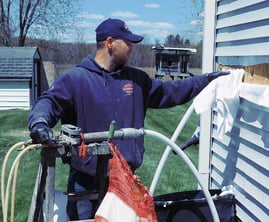 Your exterior walls can absolutely be insulated with injection foam without tearing down your drywall.
Your exterior walls can absolutely be insulated with injection foam without tearing down your drywall.
As a matter of fact, it can be done from the outside and the process only varies depending on the type of siding your home has.
“The process is as simple as working with the siding, drilling holes into the wall cavity, injecting the foam, plugging the hole, and leaving your home looking even better than it did when we arrived,” said Massey.
RELATED: How to Insulate a House Without Taking Down Drywall
Misconception: Spray Foam Insulation is Flammable
RetroFoam of Michigan uses the safest products on the market. So, is spray foam flammable?
Our injection foam is Class One Fire Rated, and so is our spray foam.
Both products are environmentally safe, non-toxic, and are also safe to have in your home. These foam insulations don’t promote the spreading of fire and will actually extinguish once the flame is removed.
“The fact that spray foam creates an air seal can help snuff out potential attic fires where the mechanicals are present,” Garcia said.
Misconception: More Insulation is Better
More isn’t necessarily better.
You could fill a space like your attic with fiberglass or cellulose, but that still isn’t going to stop air leakage because both of those materials still allow for air movement.
Foam insulation creates an air seal with a minimum of 3-inches of open cell or 2-inches of closed cell.
“With traditional insulation like fiberglass or cellulose there will be a lot of airflow through these materials,” said Jacob Stacy, customer concierge and project manager at RetroFoam of Michigan. “This leads to a sizeable amount of heat and central air loss.”
RELATED: How Thick Does Spray Foam Insulation Need to Be?
Misconception: Foam Insulation is Way More Expensive than Fiberglass or Cellulose
Foam insulation is typically about two to three times more expensive than fiberglass or cellulose, but that’s not the whole picture.
Something to consider is that traditional insulation needs to be constantly maintained and eventually replaced. Foam insulation doesn’t need to be maintained and will never need to be replaced unless it is tampered with, making the up-front cost worth it.
Foam insulation actually saves you more money in the long-run on monthly energy bills because it creates an air seal.
This air seal works to keep the air you pay to condition inside while keeping those hot or cold temperatures outside where they belong. Fiberglass and cellulose still allow for air leakage, which will end up costing you money.
“The lifespan of traditional insulation can range between 15 to 20 years before it will need to be updated, while foam will last the lifetime of your home,” Stacy said. “Fiberglass and cellulose end up costing you more just in the cost of reinsulating and wasted energy.”
RELATED: The Total Lifetime Cost of Foam Insulation: It’s Less Than You Think
Learn More About Foam Insulation
Clearing up these misconceptions about foam insulation probably has you curious about the benefits of foam for your project.
If you want to continue your educational journey, check out the Learning Center on our website.
Related Articles
The Most Frequently Asked Questions and Answers About Spray Foam Insulation for Pole Barns
Spray Foam Insulation for New Build Homes: Answers to Frequently Asked Questions
Answers to the Most Frequently Asked Questions About Foam Insulation for Existing Homes
About Amanda Emery
Amanda previously has worked as a breaking news and crime reporter, TV news producer, and editor in Flint and Detroit. Throughout her career as a journalist, she has won several awards from The Society of Professional Journalists - Detroit Chapter and the Michigan Press Association. As part of the RetroFoam of Michigan family, Amanda uses her experience as a journalist to write content that will help educate homeowners on the benefits of foam insulation. When Amanda isn’t writing, she’s spending time with her husband and rescued huskies. She also loves knitting, making art, cooking, and hosting dinner and a movie night for friends and family.



